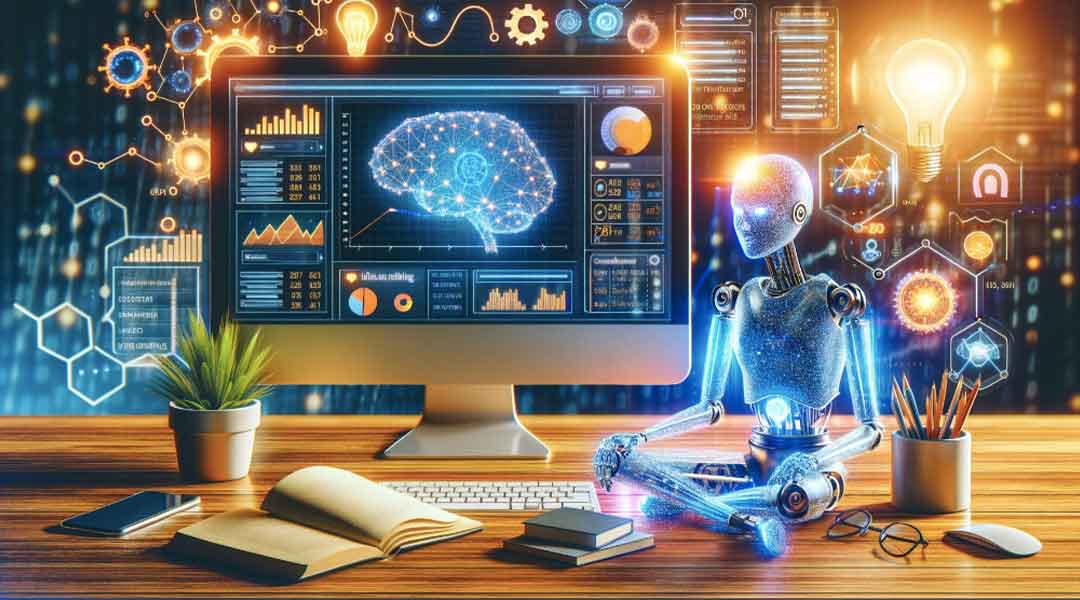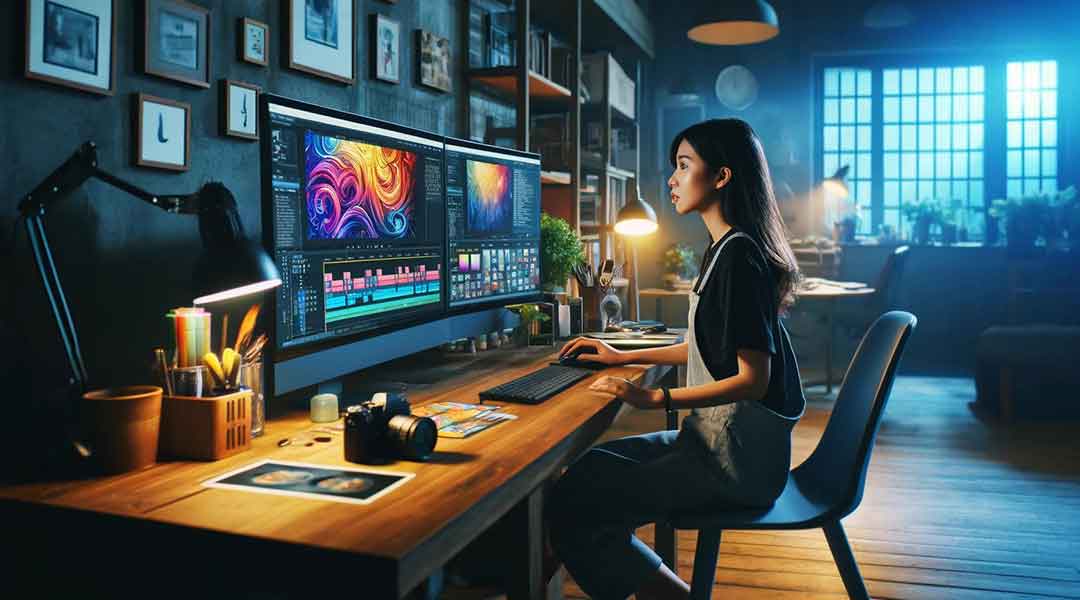When you step into using AI-generated images, remember the end goal: boosting your site’s SEO performance. Search engines are smarter now; they favor sites that offer a great user experience and relevant content. AI-created visuals can help with both but need optimization to truly shine in search rankings.
This article points out how leveraging such images effectively can change the game for your website by improving engagement and visibility online. Every visual you include on your pages isn’t just decoration. It’s an opportunity to climb higher in search results.
By following guidance on optimizing these AI-crafted assets, you set up each page for success in today’s competitive digital scene. First impressions count more than ever before.
The Importance of Images in SEO
- Enhanced User Experience: Images make your content more attractive and engaging. This keeps users on your page longer, reducing bounce rates. By breaking up text, visuals help convey your message in a digestible format. High-quality images can significantly improve the overall user experience.
- Increased Content Relevance: Carefully chosen images enhance the context of your articles or posts. For instance, an AI-generated chart makes complex information easy to grasp for readers. Such relevant imagery boosts the value of your written content to both users and search engines alike.
- Improved SEO Metrics: Optimized images directly lift key website performance indicators like dwell time and click-through rates (CTR). Moreover, they contribute to faster page loading times—a critical factor Google uses when ranking sites. By incorporating quality visuals into your strategy, you’re likely enhancing site metrics that matter most for SEO success.
What Are AI-Generated Images?
AI-generated images are pictures made by software that learns from data to create new, unique visuals. Unlike common stock photos, these images can closely match your specific needs or brand’s style. This means you get artwork that stands out and fits what you’re talking about better.
Creating these images is fast and less expensive than traditional methods. You don’t have to spend a lot on licensing fees as you might with regular stock photos since many AI tools let you use the images freely under certain rules. It’s key, though, to read each platform’s usage terms carefully.
Today’s AI image creation tools offer extensive customization options, coming in handy for SEO strategies by helping content be more relevant and appealing without breaking the bank or running into legal issues over photo use.
Best Practices for Optimizing AI-Generated Images for SEO
Optimizing AI-generated images for SEO requires careful attention to detail. Here are some best practices you can follow:
- File Size and Format Optimization: Reducing file size speeds up your website, which is crucial for good SEO ranking. Use compression tools like TinyPNG or ShortPixel without losing quality. Next-gen formats like WebP enhance loading times significantly. Smaller, faster-loading images contribute to a better user experience.
- Add Descriptive Alt Text: Alt text boosts accessibility and helps search engines grasp image content. Incorporate relevant keywords naturally in descriptions, such as “AI-generated cat playing with yarn.” This approach aids visually impaired users and improves your site’s SEO by providing context.
- Image File Naming: Descriptive names help search engines understand what an image depicts. Avoid generic names; instead, use specific ones, including primary keywords. For example, rename “IMG001.jpg” to “ai-generated-cat-image.jpg.” Proper naming increases the chances of appearing in related searches.
How AI-Generated Images Boost SEO Performance
AI-generated images can significantly enhance your SEO efforts if you optimize them well. These custom visuals hold the user’s attention longer than standard stock photos, which increases dwell time on your website. This signals to search engines that your content is captivating, potentially boosting your site’s rankings.
By incorporating unique imagery tailored specifically for your brand, you also strengthen its identity and foster trust among visitors. Solidlid brand recognition contributes to higher engagement rates and encourages repeat visits. Moreover, engaging AI-created images are more likely to get shared on social media platforms.
As these shares accumulate, they create backlinks and generate social signals that indirectly elevate your SEO performance by signaling relevance and popularity to search engines. In addition, when you properly label and describe these AI-generated pictures using relevant keywords without spamming—a process known as image optimization—there’s a better chance they will rank in Google Images searches. Ranking high in this space directs more organic traffic toward your website since people exploring visual content could click through after discovering an eye-catching image related directly to their interests or needs.
In essence, utilizing AI to create dynamic visuals not only enriches the user experience but also plays into strategic elements of SEO best practices by enhancing engagement levels, promoting brand fidelity, and improving visibility across digital channels.
Tools to Create and Optimize AI-Generated Images
- Creative generation: DALL·E and MidJourney are top choices for creating unique visuals. Both can produce images that stand out in search results, helping to attract clicks. Their technology focuses on generating artistic, high-quality pictures from the textual descriptions you provided. This capability allows for the production of tailor-made images aligned with your content strategy.:
- Image optimization efficiency: TinyPNG and ShortPixel ensure your AI-generated graphics are web-ready.: These tools optimize image sizes without sacrificing visual quality, which is crucial for page load speed—a factor in Google’s ranking algorithm. They use advanced compression algorithms to shrink file sizes significantly while maintaining clarity and detail.
- Streamlining optimization processes: WordPress plugins such as Smush or Imagify offer automated solutions.: By handling tasks like resizing, compressing, and lazy loading within your CMS environment, these tools save you considerable time.
Pitfalls to Avoid with AI-Generated Images
Using too many AI-generated images might make your site look common and artificial. It’s vital to mix in real photos to keep things authentic. Also, don’t forget about copyright issues.
Each tool comes with its own rules for using its images, so always check the licensing terms before use. Your visuals should reflect your brand voice and match your website’s overall design. Mismatched imagery can confuse visitors or weaken your branding efforts.
On a technical note, never overlook essential SEO elements like alt text or lazy loading features for these images. These steps are crucial for enhancing search visibility and ensuring a fast-loading website experience—key factors that contribute significantly to improving SERP rankings.
- Optimize file sizes: Keeping image files as small as possible is crucial for page load speed, a key SEO factor. Use compression tools to reduce the size without losing quality. Faster loading times lead to better user experiences and higher rankings on search engine results pages.
- Include descriptive alt text: Alt text plays an essential role in making visuals accessible and understandable by search engines. Describe each AI-generated image with clarity and relevance to your content topic. This practice not only aids visually impaired users but also helps search engines index your images more effectively.
- Align visuals with content strategy: AI-generated images should complement your overall content strategy, adding value rather than serving merely as decoration. Tailor these images so they resonate with your written content’s themes and messages, enhancing reader engagement and contributing positively to SEO outcomes through improved dwell time and reduced bounce rates.
FAQs or Pro Tips
Engaging visuals are crucial for capturing the reader’s attention. AI-generated images offer a customizable solution that fits perfectly with any content strategy.
- Sample: Are AI images effective for blog engagement?: AI-generated pictures keep readers hooked by offering fresh, unique visual experiences. Using them on blogs can significantly increase the time spent on the age. This signals to search engines that your content is valuable, potentially improving rankings. Plus, these visuals make your posts more shareable across social platforms.
- Sample: How do I choose where to place images in my post?: Placement can affect how long visitors stay on your site. Try placing an image near the top to grab attention immediately. Then, additional images should be integrated throughout the text to maintain interest and illustrate points clearly. Observing metrics like bounce rate after adjustments helps identify optimal positioning.
- Utilizing split-testing methods: Split-testing different arrangements of imagery unveils what captures the audience’s interests best. Test several layouts and monitor key performance indicators such as click-through rates or session duration. Regularly analyze results and refine placements accordingly. Effective experimentation iterates towards an ideal balance between text and visuals.
Utilizing AI-generated images boosts SEO by providing original, relevant visuals that engage users and decrease bounce rates. For best outcomes, ensure these images align with your content’s topic or keywords. Optimally tag each image with descriptive file names and alt text to improve accessibility and search engine understanding.
Remember, while AI can create captivating visuals, blending them with high-quality written content maximizes their effectiveness in driving traffic to your site. By following this approach, you’ll enrich the user experience and enhance your website’s visibility on search engines effectively.









